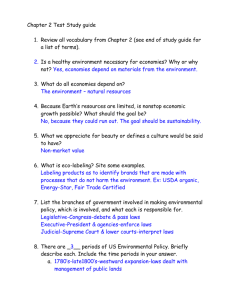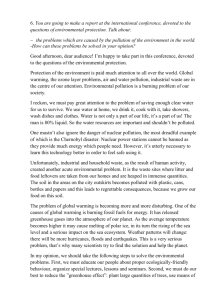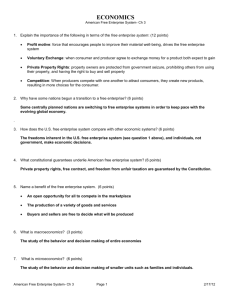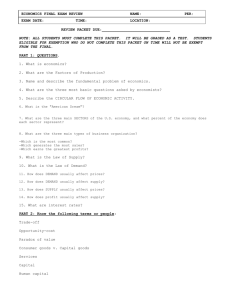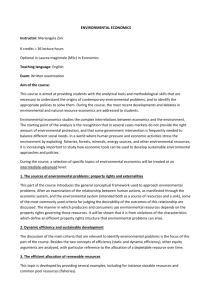Environmental Economics and Policy
advertisement
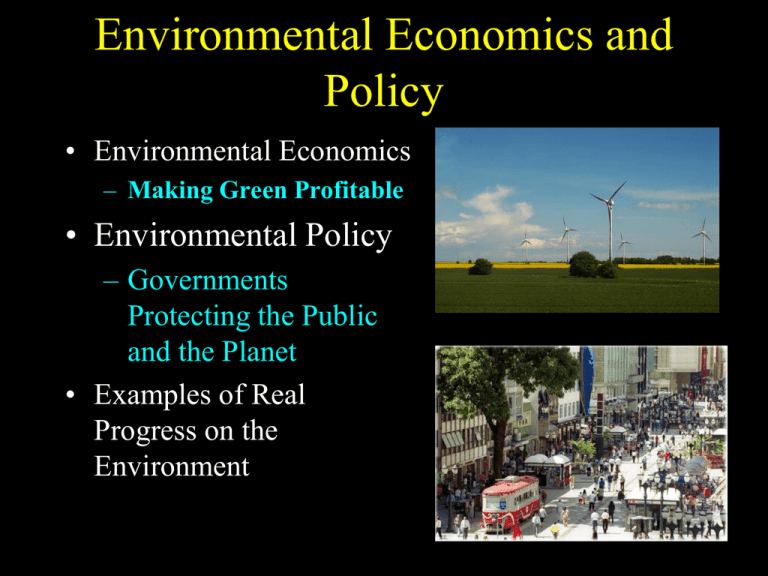
Environmental Economics and Policy • Environmental Economics – Making Green Profitable • Environmental Policy – Governments Protecting the Public and the Planet • Examples of Real Progress on the Environment Environment and economy are intricately linked. • • Economies receive inputs of resources from the environment, process them in complex ways that enable human society to function, then discharge outputs of waste into the environment. Environmental systems support economies, purifying air and water, cycling nutrients, providing pollination, and serving as receptacles for waste; these are called ecosystem services. Environmental Economics How to measure economic productivity? • Accounting at all levels needs to better reflect the true, long-term, sustainable value of economic activities. • Many practices that today are “profitable” are clearly actually contributing to long-term degradation of natural systems and human well-being. They are, in truth, counterproductive. Classical Economics Adam Smith helped found classical economics. The Theory of Moral Sentiments, 1759 The Wealth of Nations, 1776 Adam Smith (1723-1790) Adam Smith, the father of classical economics, believed that when people are free to pursue their own economic self-interest in a competitive marketplace, the marketplace will behave as if guided by “an invisible hand” that ensures their actions will benefit society. He assumes resources are unlimited. Neoclassical economics incorporates psychology and cost-benefit analysis. • The conflict between buyers and sellers results in a compromise price being reached and the “right” quantity of commodities being bought and sold. • In cost-benefit analysis, the estimated costs for a proposed action are totaled and compared to the sum of benefits estimated to result from the action. • Economic benefits tend to be overrepresented in traditional cost-benefit analyses because they’re more easily identified. • Not all costs and benefits are easily identified, defined, or quantified, or even identified or defined. Neoclassical economics has profound implications for the environment. • • • Workers and other resources are assumed to be infinite or substitutable. Long-term effects, occurring far in the future, are discounted. Costs and benefits are assumed to be internal to all transactions (e.g. it ignores “externalities”) – – • The market does not take the costs of pollution into account. Costs or benefits of a transaction are assumed to all be borne by individuals engaging in the transaction. However, this is often incorrect. There can be external costs, such as health problems or pollution cleanup, which are paid by others. Growth is required to keep employment high and maintain social order. Problems with Gross Domestic Product (GDP) GDP is used to account for economic growth or decline and GDP per capita is a widely-used indicator of relative wealth, progress, and well-being. • GDP takes no account of the inputs used to produce the output. For example, if everyone worked for twice the number of hours, then GDP might roughly double, but this does not necessarily mean that workers are better off as they would have less leisure time. Similarly, the impact of economic activity on the environment is not measured in calculating GDP. • GDP does not measure factors that affect quality of life, such as the quality of the environment and security from crime. This leads to distortions - for example, spending on cleaning up an oil spill is included in GDP, but the negative impact of the spill on well-being (e.g. loss of clean beaches) is not measured. These “externalities” are critical to true valuation of economic activity but are not counted. • Measures of GDP exclude unpaid economic activity, most importantly domestic work such as childcare. This leads to distortions; for example, a paid nanny's income contributes to GDP, but an unpaid parent's time spent caring for children will not, even though they are both carrying out the same economic activity. Ecosystem Services are not currently incorporated into accounting. Ecosystem services (clean water, pollination, etc.) are said to have “non-market values”, values not usually included in the price of a good or service. • One technique of assigning non-market value is using surveys to determine how much people would be willing to pay to protect a resource or to restore it. • An alternative approach is to calculate the overall economic value of all services that an ecosystem provides. “In 1997, an international team of economists and environmental scientists put a dollar amount on all the ecosystems services provided to humanity free of charge by the living natural environment. Drawing from multiple databases, they estimated the contribution to be $33 trillion or more each year. This amount is nearly twice the 1997 combined gross national product (GNP) of all countries in the world, or gross world product, of $18 trillion.” E.O. Wilson, 2002 Economists disagree on whether economic growth is sustainable. Many observers worry that growth has become an end in itself. Resources are ultimately limited, they argue, so nonstop growth is not sustainable. versus Some proponents of unrestrained growth believe that technology can solve everything. • Ecological economists argue that civilizations do not overcome environmental limitations in the long run. They advocate economies that are stable, neither growing nor shrinking; these steady-state economies are intended to mirror natural ecological systems. • Environmental economists maintain that we can attain sustainability within our current economic systems by modifying the principles of neoclassical economics to address environmental challenges. The Real Cost of Gasoline Market Price for a Gallon of Gas (1994) $1.60 Real Cost of a Gallon of Gas (1994) $12/gallon How and spent to How much much for costcancer, to addasthma, for the billions emphysema fromtoairPersian pollution? preserve access Gulf Oil? How dependence onfreeways? unfriendly How much much for for supply lives lost on suburban states and tax subsidies for oil companies? How much for oil water warming pollution?and thespills costsand of global resulting fires, floods, droughts, and blizzards? U.S. Environmental Policy First wave of U.S. environmental policy addressed land management. • The early environmental laws were intended to promote settlement, and the extraction and use of the West’s abundant natural resources. • The Western lands were considered practically infinite, and inexhaustible in natural resources. – General Land Ordinances of 1785 and 1787 (Thomas Jefferson’s Township and Range System) provides mechanism and structure for taking of Native American lands. Second wave of U.S. environmental policy addressed impacts of the first. • During this time the government created national parks, wildlife refuges, and the forest system. Grand Canyon of the Yellowstone, 1872 by Thomas Moran John Muir & Teddy Roosevelt in Yosemite Earth Day April 22, 1970 20 million Americans participated! The public demanded that the federal government do more to protect the environment. Why? • The publication of Rachel Carson’s Silent Spring, 1962 • The burning of the Cuyahoga River on several occasions in the 1950s and 1960s. • The Santa Barbara, California oil spill in 1969. The third wave responded largely to pollution. NEPA (National Environmental Policy Act, 1970) was signed in 1970 and require EIS (Environmental Impact Statement) for federal actions and The Environmental Protection Agency (EPA) is created. Other prominent laws followed: Two major laws were the Federal Water Pollution Control Acts (1965 and 1972) and Clean Water Act (1977). Approaches to Environmental Policy 1. Command-and-control approach sets strict legal limits, and punishments, in what is sometimes called a approach. A subsidy is a government giveaway of cash or publicly owned resources used to promote a particular activity. 2. Subsidies can be used to promote environmentally sustainable activities, but often they have been used to prop up unsustainable ones. Market incentives are being tried widely on the local level. 3. Green taxes (pollution taxes) discourage undesirable activities. By taxing activities and products that cause undesirable environmental impacts, a green tax becomes a tool for policy as well as a way to fund government. Green taxes do not have much support in the United States, although they have been widely instituted in Europe. Approaches to Environmental Policy 4. Markets in permits can save money and produce The government can issue permits to individual polluters. They may buy, sell, and trade these marketable emissions permits; this provides financial incentives to reduce pollution. (e.g. “Cap and Trade” efforts at carbon dioxide reduction). 5. Ecolabeling tells consumers which brands use environmentally benign processes. (e.g Fair Trade and USDA Organic products). The Fourth Wave: Make the Market Tell the Truth! Market forces are a powerful tool for improving efficiency and changing consumption patterns. However, this is true only if we properly account for environmental damage. Moreover, free markets do not work in the “commons.” Genuine Progress Indicator (GPI) • When calculating whether or not economic activities have actually increased well being GPI takes externalities into account, such as: •Cost of resource depletion •Cost of crime •Cost of ozone depletion •Cost of family breakdown •Cost of air, water, and noise pollution •Loss of farmland •Loss of wetlands • debated by the EU and Canada. It is being used as a component of legislative decisions in these countries. “At least 11 countries (including Austria, England, Sweden and Germany) have recalculated their gross domestic product using the GPI. The data for European countries and the United States show a steady decline over the last 30 years. Source: REAL WEALTH Linda Baker, Earth Action Network January 5 1999 cited on Wikipedia.org. The Fourth Wave: Break Fossil Fuel Addiction! One gallon of gas contains the energy equivalent of about 600 hours of human manual labor. Source: McKibben, B. 2010. Eaarth: Making Life on a Tough New Planet . The The U.S. average Department American uses of Energy almost three estimates gallons that per day the world or roughly consumes the equivalent about of 3,528,000,000 1,800 hours of gallons manualper labor. day. Source: U.S. Energy Information Administration. Energy Explained. www.eia.doe.gov/energyexplained/ Source: World Resources Institute. 2007. Vital Signs 2007-2008. The Fourth Wave: A Sense of Purpose and Urgency • These challenges present an opportunity: fighting to save civilization is an inspiring cause. • A cleaner, greener world will be better, healthier world. It is not a sacrifice; it’s an improvement! • We can make products that work with nature, not against it. Biomimicry will be key. • Science can and should lead the way. Stabilize Population Growth Good news for a change! By roughly 2050 human populations will stabilize and begin to fall. The sooner this happens, the better. Expand Preserves and Regenerate Damaged Ecosystems • Create a worldwide network of marine and terrestrial preserves (aim for 20% of each). • Plant trees on a war footing in the developing world. • These will strengthen the system’s ability to recover and regenerate, to heal. Forests will recover when left alone. 2005 Williams, M. Observatory/Image 1989. Americans and forests. Cambridge University Press. from Michael Goudie, Lefsky. A. 2000 Source: NASA Earth bytheir Jesse Allen and Robert Simmon/Based onTaken data from Marine environments recover very quickly, if left unmolested. Reviews of global data show that marine reserves produce major benefits in just the first two years: • 91% increase in density of organisms • 192% increase in biomass of organisms • 31% increase in average size of organisms • 23% increase in species diversity Sources: Halpern, Benjamin S. 2003. The Impact Of Marine Reserves: Do Reserves Work And Does Reserve Size Matter? Ecological Applications 13; Withgott and Brennan. 2009. The Essential Environment. Pearson. Government Interventions • Apollo Mission for clean energy now. • Eliminate all subsidies and tax breaks for dirty energy production. • Require green accounting practices. • Ban or limit the most destructive practices, especially in the oceans, rivers, and atmosphere (e.g. trawling, tuna fishing, CFCs, toxic pollution). • Most radically: shift gradually from income taxes to pollution taxes. Real Progress • In 1850 New Hampshire was 35% woods; today it is 80% woods. Much of Massachusetts, New Hampshire, and New York exhibit similar patterns. • Costa Rica now protects 25% of its entire country in national parks. • The European Union (EU) and Britain increasingly incorporate sustainability into policy decisions and are rapidly reducing their dependence on fossil fuels. Real Progress Clean Air Act, 1970 • EPA successfully improved ozone (smog), carbon monoxide, sulfur dioxide, nitrogen dioxide, lead, and particulate soot in U.S. • EPA announced in April of 2009 that CO2 is a pollutant and will be regulated. Source: AQMD.gov, 2009 Real Progress Denmark no longer imports oil for electricity because of widespread adoption of wind power. Iceland no longer imports oil for electricity because of widespread construction of geothermal power plants. Brazil no longer imports oil for electricity now that it uses sugar cane to make bio-fuels. Nic Marks on the Happy Planet Index (HPI) http://www.ted.com/talks/nic_marks_the_happy_planet_index.html Less Stuff, More Happiness: Graham Hill William McDonough on Sustainable Economies The Next Industrial Revolution on YouTube.com The revolution has begun. Global Cumulative Installed World Wind Capacity 1996-2010 Source: Global Wind Energy Council. 2010. Global Wind Report 2010. http://www.gwec.net/index.php?id=8. Join the revolution today! Buy only things you need. Buy fewer of them. Buy higher quality. Organize, Demand clean energy. Support policies, groups, and politicians that move us toward a reduce, reuse, and recycle economy. Spread the word. Advocate for the environment. Protect it Because a good planet is hard to find. Source: NASA, MODIS Get involved • 350.ORG www.350.org • Natural Resources Defense Council www.nrdc.org • World Wildlife Fund http://www.worldwildlife.org/ • The Sierra Club www.sierraclub.org • Friends of the Earth http://www.foei.org/ • Treehugger.com http://www.treehugger.com/ Resources • Lester Brown. 2010. Plan B 4.0 Mobilizing to Save Civilization. http://www.earth-policy.org/index.php?/books/pb4/pb4_table_of_contents • The U.N. Millennium Ecosystem Assessment, 2005. http://www.maweb.org/en/index.aspx • International Panel on Climate Change, 4th Assessment Summary for Policy Makers, 2007. http://www.ipcc.ch/publications_and_data/ar4/syr/en/spm.html • United States Federal Global Change Research Program. http://www.globalchange.gov/publications/reports/scientific-assessments/usimpacts • The World Wildlife Fund. Living Planet Report, 2010. http://wwf.panda.org/about_our_earth/all_publications/living_planet_report/ • Beyond GDP Initiative. European Commission. http://www.beyondgdp.eu/news.html

